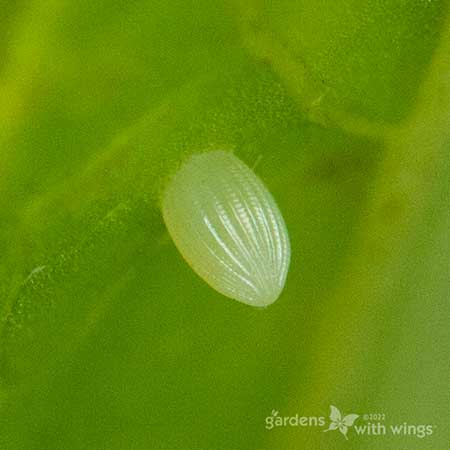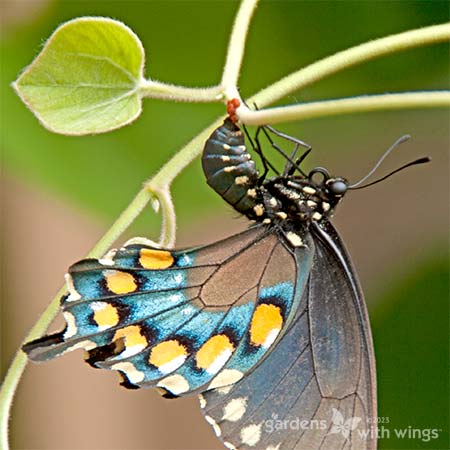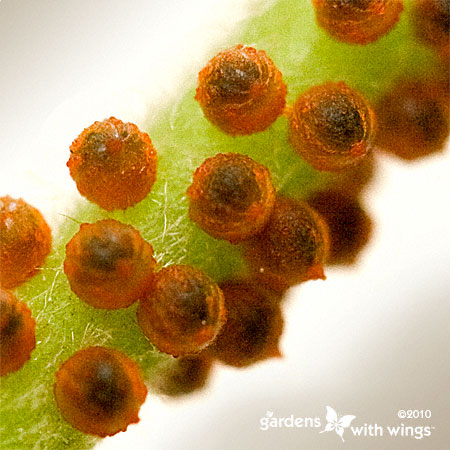Did Someone Say Butterfly Eggs?
When you are thinking of finding butterfly eggs, there are things that you will already know, yet going butterfly egg hunting might still be new to you! The size and locations of the butterfly eggs will always depend on the species.
What Do Butterfly Eggs Look Like?
Before we learn how to identify butterflies by their eggs, we have to know the general information on what butterfly eggs look like. First of all, they are tiny – usually no larger than a pinhead as seen in the above photo. In many cases, a single egg is laid on the underside of the leaves. The eggs will gradually change color as they mature.
Still, what size is an egg? They are between 1 and 3 mm. The most interesting part is that there are many different colors and shapes. For example, the Painted Lady eggs are pale green and oblong, whereas the Pipevine Swallowtail lays clusters of round red-brown eggs. Here is a quick guide to Identify Four Types of Butterfly Eggs.
Where Do Butterflies Lay Eggs?
For some butterflies like Black Swallowtails and Gulf Fritillaries, you will find their eggs on top of the leaves, while others like the famous Monarchs will lay them on the underside.

But how do butterflies know where to lay their eggs, you might ask? It happens after the mating process when the female looks for a plant to lay her eggs. The female butterfly is selective when choosing her plant because the caterpillars won’t eat just anything! Essentially, it has to be the right plant, and with plenty of leaves, so there is enough food!
You can take your time to study the butterflies and explore various butterfly egg images before you explore the plants and learn about all the peculiarities as you go hunting!
Helpful Tips to Find Butterfly Eggs
The easiest way to find eggs is by watching the butterfly lay her eggs on a plant. For instance, if you have milkweed in your garden, watch for a monarch flying around the plants. If the butterfly flies into the plants and out again several times, there’s a good chance it is a female laying her eggs.
Once you watch the female lay her eggs, it will provide you with an idea of where to look as you examine the plant. The trick is to take a closer look and examine the back of a leaf, the top, and the stem.

Some butterflies lay eggs in groups, as in the Pipevine Swallowtail. The Monarch butterfly lays her eggs one at a time on several leaves and stems. As you are observing the butterflies, you can see how their abdomen bends and touches the leaf. There’s a good chance an egg will be laid there.
It’s best not to disturb the female while she is laying her eggs and make sure that you do not bend or abuse the plant!
If you miss the right moment to see a female butterfly lay her eggs, watch this video of a Zebra Swallowtail laying eggs on a Pawpaw Tree to see how she does it!
Become Familiar with Host Plants
Not all plants make suitable host plants! Butterflies require special plants to lay their eggs on. Therefore, it is essential to become familiar with these plants. If you do not have host plants in your garden, you can plant them. You will then have the opportunity to find the eggs and observe the entire butterfly life cycle right in your garden!
The Gardens With Wings website provides a cross-reference from the host plant to the butterfly to help you know which plant you need for which butterfly. See an example of the plant and butterfly cross-reference by visiting the Pipevine Plant page. Information about where to buy plants is included
As you take your time to learn more about the host plants, you will know where to look for eggs and make your journey even more interesting. When you know more about how to identify the host plants, you also learn how to identify the butterflies! Let’s review an example.
Spicebush Swallowtail Laying Eggs
We have several spicebush plants in our garden. The spicebush is the host plant for the Spicebush Swallowtail. We have a great treat for you as we had good luck spotting the beautiful Spicebush Swallowtail flying around one of our plants, so we have captured the entire experience. This is how we found the egg, as you can see here.
Now you know how to find butterfly eggs! Remember to plant host plants in your garden!
Next up…






